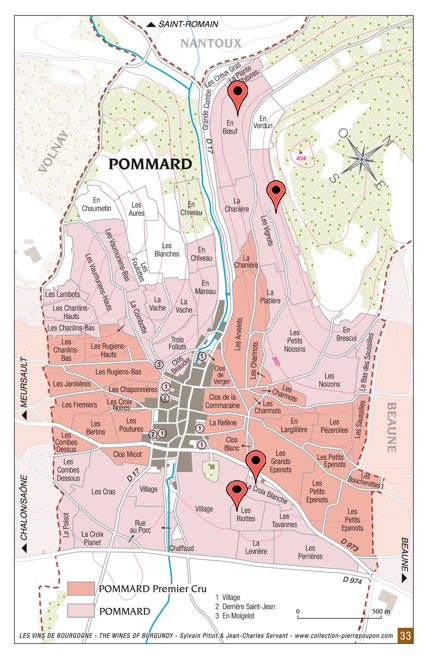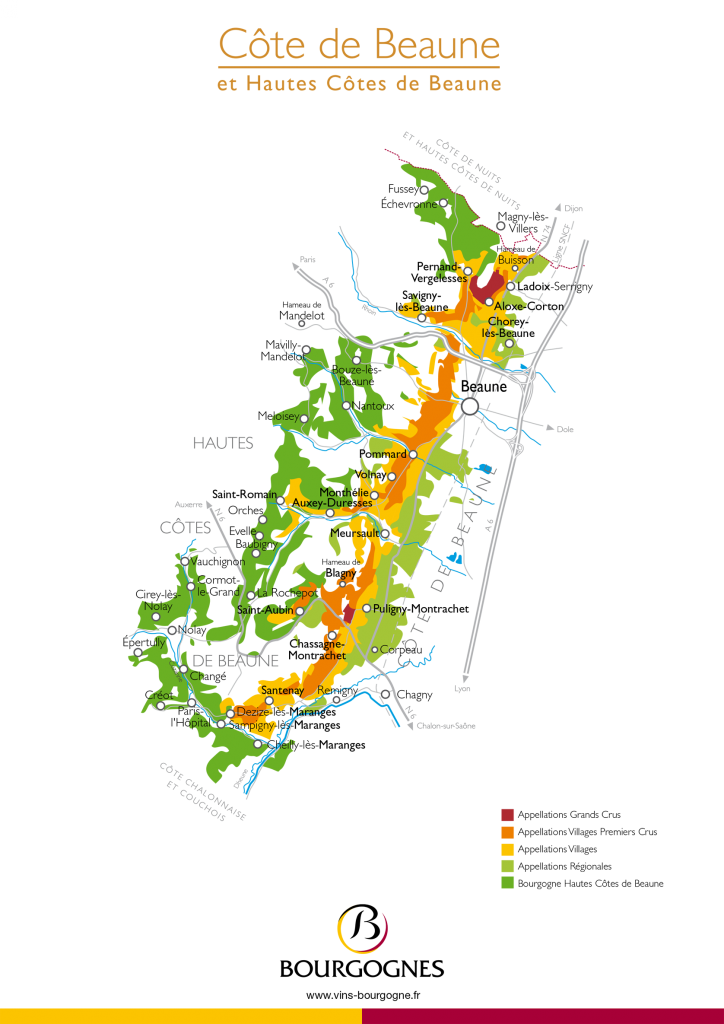POMMARD

Village in the south of the Côte de Beaune with 320 hectares of vines.
Historical background of the POMMARD appellation
Considered as “The pick of the wines of Beaune area” since the Middle Ages, Pommard has always been synonymous with powerful wines, strong bouquets and long aging.
– Location: " vineyards”:
This named place called is one of the most highly-reputed of the appellation. It is situated near the Premier Cru parcels of “Les Arvelets” and “La Platière”, at the very top of the hillside slope, hence its name “Les Vignots” (meaning “vines at the top”).
- The domain surface area of vines: 0.301ha.
- Number of bottles produced: 1900.
- Exposure: due south, altitude 330 m.
- Steep slope: 34%.
- Type of soil: the parcel is situated on quite a steep slope and a land of white marl with a lot of rock and very little surface soil.
- Taste characteristics: of a deep red color, the wines offer aromas of jammy red fruits and gentle spices. On the palate, they prove to be powerful, warm and complex, with fine but noticeable tannins and great persistence due to their minerality.
- Serving temperature: 15-16°C; it is often desirable to decant recent vintages to amplify their aromatic expression.
There is also a tank created from the blending of 3 parcels (Les Riottes, la Croix Blanche, les Bœufs).
- Surface area of vines for this tank: 0.376ha.
- Number of bottles produced: 2400.
- Serving temperature: 15-16°C; it is often desirable to decant recent vintages to amplify their aromatic expression.
Place called: “Les Riottes”:
Derived from “petite rue” (little street) in Old French. Situated besides the vines of the Château de Pommard in this same place called, it is noted for the quality of its clay soils.
- Domain surface area of vines: 0.095ha.
- Slope: none.
- Type of soil: Limestone soil, shallow and very draining noted for the quality of its clay soils and its low limestone content.
- Taste characteristics: a lot of power allied to great finesse, a fruity wine with silky tannins linking unctuousness and volume on the palate. Rich, deep and at the same time ethereal, the wine from Les Riottes brings its noble credentials to the final assembly.
Location: " White Cross”:
These vines are situated very close to Les Épenots, near the old Pommard railway station where a train used to run between Beaune and Bligny sur Ouche.
- Domain surface area of vines: 0.087ha.
- Slope: none.
- Type of soil: clay, shallow limestone, silts.
- Taste characteristics: notes of ripe fruits; unctuousness gives way to minerality; straight-line, precise and strongly structured wines.
Location: " Cows " :
- Domain surface area of vines: 0.194ha.
- Slope: none.
- Type of soil: clay, limestone, pebbles.
- Taste characteristics: deep red color, limpid with hints of garnet. An intense bouquet of red fruits, with floral notes. A firm but frank first impression on the palate, with aromas of red fruits. The tannic thread is full of elegance.
BURGUNDY HIGH CÔTES DE BEAUNE
Historical background to the Burgundy Hautes Côtes de Beaune appellation:
Created in 1961, this appellation in Côte d'Or spreads over 12 communes of the Hautes Côtes and in the upper vineyards of 10 communes of the Côte de Beaune. The rest is situated in continuation southwards, in the department of Saône et Loire.
The domain works 1.675ha of vines made up of parcels in different localities around the village of Meloisey, heartland of the appellation.
Place called “Le Clou”:
Burgundian place-name variant of “clos”, designating a lordly vineyard enclosed by walls.
- Surface area: 0.656ha.
- Number of bottles produced: 5300.
- Exposure: south-east, altitude 350 to 380 m.
- Slope: 10 to 12%.
- Type of soil: light, clayey.
- Taste characteristics: this parcel produces a well colored wine, with aromas of fresh red fruits; mineral and with very good tension on the palate.
- Serving temperature: 15-16°C; it is often desirable to decant recent vintages to amplify their aromatic expression.
Place called “Dalignère”:
- Surface area: 0.38ha.
- Number of bottles produced: 3000.
- Exposure: south-east, altitude around 350 m.
- Slope: 3 to 5%.
- Type of soil: shallow; red earth and fine pebbles.
- Taste characteristics: the wines from this parcel are characterized by lovely fruit maturity, with great complexity over a more integrated tannic base.
- Serving temperature: 15-16°C; it is often desirable to decant recent vintages to amplify their aromatic expression.
Place called “Clos de la Perrière”:
The term “Perrières” refers to the former quarries that long existed near these vines.
- Surface area: 0.64ha.
- Number of bottles produced: around 5200.
- Exposure: south, altitude around 350 m.
- Slope: 3 to 5%.
- Type of soil: shallow; red earth and fine pebbles.
- Taste characteristics: the wines from this parcel are characterized by the dominant characteristic of well-ripened red fruits, with great complexity over a more integrated tannic base. The palate is well structured, with powerful tannins.
- Serving temperature: 15-16°C; it is often desirable to decant recent vintages to amplify their aromatic expression.



